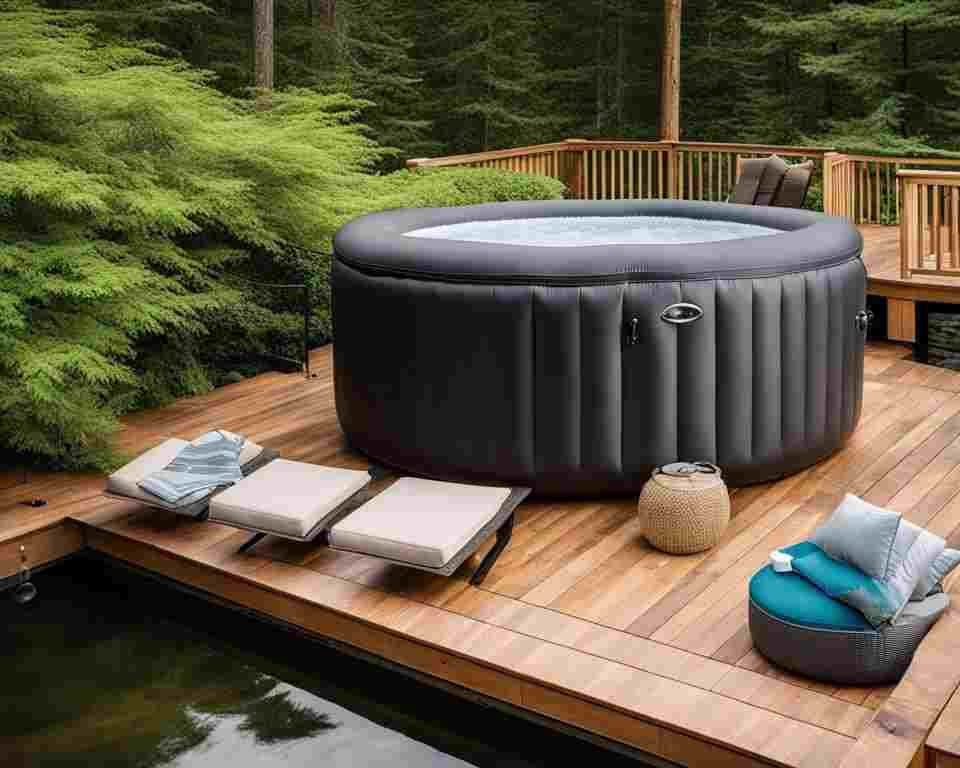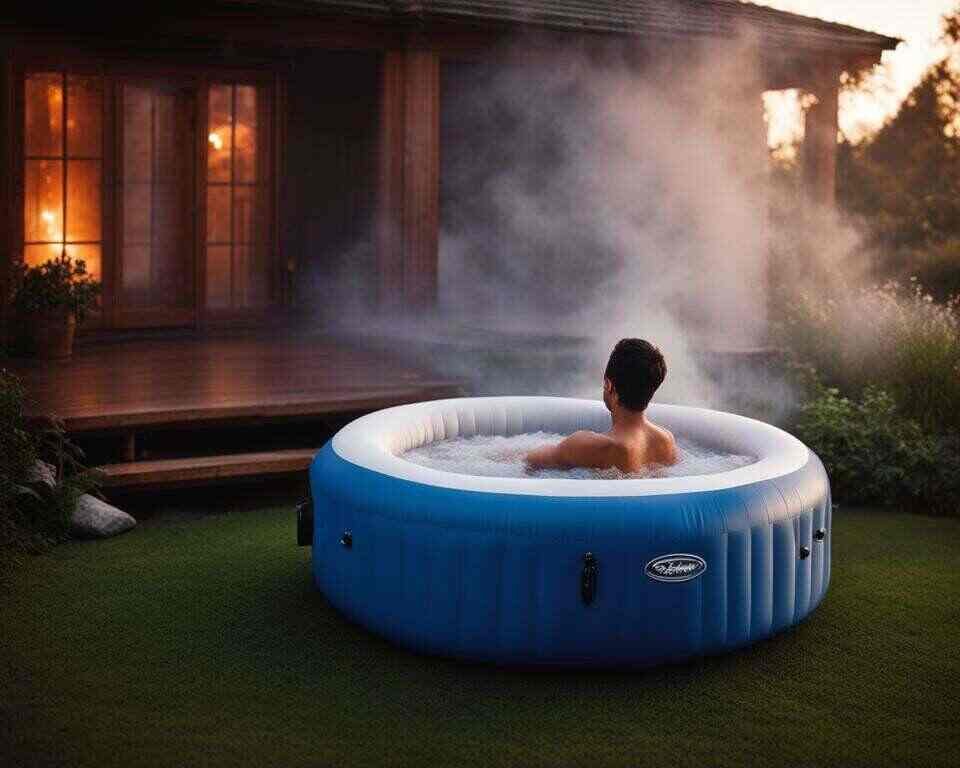When it comes to inflatable hot tubs, one common question that arises is whether they need to be constantly turned on. Understanding the optimal usage and energy-saving tips for these portable tubs can help you make informed decisions regarding their operation. In this article, I will explore the need for continuous operation, the impact on maintenance and longevity, and provide insights into the energy efficiency of inflatable hot tubs.
Key Takeaways:
- Inflatable hot tubs do not need to be on all the time for optimal use.
- Constant operation can negatively impact power consumption and maintenance requirements.
- Evaluating power consumption and energy efficiency is essential for efficient hot tub usage.
- Understanding hot tub heating mechanics can help you make informed decisions about usage patterns.
- Implementing energy-saving tips can help you reduce power consumption while enjoying your hot tub.

Understanding Inflatable Hot Tubs’ Operation
In this section, we will dive into the operation of inflatable hot tubs. Understanding how these tubs function is crucial in determining their power consumption and energy efficiency.
Power Consumption and Energy Efficiency
When it comes to owning an inflatable hot tub, it’s important to consider its power consumption and energy efficiency. By understanding these factors, you can make informed decisions about the operation of your hot tub and potentially save on energy costs.
Inflatable hot tubs are designed to provide a relaxing and enjoyable experience while minimizing power consumption. They typically feature a heating element and an insulated cover to sustain the desired water temperature.
The power consumption of an inflatable hot tub is influenced by various factors, including the water volume, insulation quality, ambient temperature, and desired water temperature. Higher water volume and lower insulation quality may require more energy to heat the water and maintain the desired temperature.
Energy efficiency in inflatable hot tubs can be enhanced through several practices. One effective method is to switch off the hot tub when it is not in use. This helps conserve energy and reduces unnecessary power consumption. Additionally, regularly cleaning the hot tub filter and maintaining proper water chemistry can optimize energy efficiency.
Furthermore, consider investing in a hot tub with energy-saving features, such as programmable timers and advanced insulation materials. These features can significantly reduce power consumption and enhance the overall energy efficiency of your inflatable hot tub.
By understanding the power consumption and energy efficiency of inflatable hot tubs, you can make informed decisions about their operation, ensuring a balance between optimal usage and energy conservation.
Do Inflatable Hot Tubs Need to Be On All the Time?
In this section, we will explore whether inflatable hot tubs need to be on all the time. We will evaluate the power consumption and energy efficiency of these tubs to determine the best operational practices. Additionally, we will discuss the impact of constant operation on hot tub maintenance and longevity. Finally, we will provide hot tub heating mechanics and energy-saving tips to optimize your inflatable hot tub usage.
Evaluating Power Consumption and Energy Efficiency
When considering if inflatable hot tubs should be on all the time, it is important to evaluate their power consumption and energy efficiency. Hot tubs are designed to keep water at a constant temperature, which requires energy. However, leaving the hot tub continuously running can result in higher electricity bills and unnecessary energy usage. It is recommended to find a balance between maintaining a comfortable water temperature and conserving energy. By monitoring and adjusting the heating settings, you can optimize the power consumption of your inflatable hot tub.
Impact of Constant Operation on Maintenance and Longevity
Constantly running an inflatable hot tub can have both positive and negative impacts on maintenance and longevity. On the one hand, continuous operation can help prevent bacteria growth and water stagnation, improving water quality and minimizing the need for frequent water changes. However, it can also lead to increased wear and tear on components such as the pump, heater, and filtration system. Regular maintenance, such as cleaning the filter, balancing the water chemistry, and inspecting the tub for any signs of damage, is crucial to ensure the longevity of the hot tub.
Proper maintenance practices, coupled with the right operational schedule, can extend the lifespan of your inflatable hot tub while minimizing the risk of costly repairs or replacements.
Hot Tub Heating Mechanics and Energy-Saving Tips
Understanding the heating mechanics of your inflatable hot tub can help you make informed decisions about its operation. Most hot tubs use an electric heater or a heat pump to warm the water. These mechanisms rely on the circulation of water and heating elements to achieve the desired temperature. To optimize energy efficiency while maintaining water heat, consider implementing the following energy-saving tips:
- Set the temperature to a comfortable but not excessively high level.
- Use a hot tub cover to minimize heat loss when the tub is not in use.
- Consider utilizing a timer to control when the hot tub is heated.
- Regularly clean and maintain the hot tub’s filtration system to ensure efficient heat transfer.
- Insulate the hot tub’s plumbing and equipment to reduce heat loss.
Implementing these energy-saving tips can help reduce power consumption and maximize the energy efficiency of your inflatable hot tub without compromising on comfort and enjoyment.

Best Practices for Inflatable Hot Tub Usage
When it comes to inflatable hot tubs, following best practices is essential for optimal usage, energy efficiency, and maintenance. By implementing these practices, you can enhance your hot tub experience while minimizing energy consumption and maximizing savings. Let’s explore the key considerations and tips to ensure the longevity and performance of your inflatable hot tub.
Energy Efficiency:
- Set the temperature to a comfortable level rather than excessively high, as it will help conserve energy.
- Consider using a hot tub cover to minimize heat loss when the tub is not in use.
- Regularly check and maintain the insulation and seals to prevent heat escape.
Maintenance:
- Clean the filters regularly to ensure efficient water circulation and prevent debris buildup.
- Test and balance the water chemistry regularly to keep it clean and safe for use.
- Regularly check for leaks, cracks, or any damage to the tub and address them promptly.
Hot Tub Care:
- Always shower before getting into the tub to reduce the introduction of contaminants.
- Limit the number of users at a time to avoid overloading the tub and straining the system.
- Properly store the hot tub when not in use, following the manufacturer’s instructions.
By following these best practices, you can enjoy a well-maintained and energy-efficient inflatable hot tub. Keep in mind that regular maintenance and care are crucial for maximizing the longevity and performance of your hot tub. Now, let’s take a look at the table below for a quick summary of the best practices discussed.
| Aspect | Best Practice |
|---|---|
| Energy Efficiency | Set temperature to a comfortable level Use a hot tub cover Check insulation and seals regularly |
| Maintenance | Clean filters regularly Test and balance water chemistry Address leaks and damage promptly |
| Hot Tub Care | Shower before entering Limit number of users Properly store when not in use |
With these best practices in mind, you can enjoy the full benefits of your inflatable hot tub while minimizing maintenance issues and optimizing energy efficiency. By taking care of your hot tub diligently, it will provide you with relaxation and enjoyment for years to come.

Conclusion
In conclusion, the need for continuous operation of inflatable hot tubs depends on individual preferences and circumstances. While some users may prefer to keep their hot tubs running all the time for immediate use and convenience, others may choose to turn them off when not in use to conserve energy and minimize costs.
To make an informed decision about continuous operation, it is crucial to assess your hot tub usage patterns and desired comfort levels. If you regularly use your hot tub and prefer it to be ready at all times, keeping it on might be the right choice for you. However, if you use it less frequently or want to reduce energy consumption, turning it off when not in use can save power and expenses.
Additionally, implementing energy-saving tips for hot tub care can further enhance efficiency and maintenance. Simple practices like keeping the hot tub cover on when not in use, regularly cleaning the filters, and maintaining the water chemistry properly can help optimize energy efficiency and prolong the lifespan of your inflatable hot tub.
By carefully evaluating the need for continuous operation and following energy-saving tips for hot tub care, you can strike the right balance between comfort, convenience, and energy efficiency. With proper maintenance and wise usage, your inflatable hot tub can provide long-lasting enjoyment while minimizing environmental impact and saving you money in the process.

